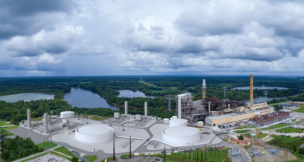Washington Gas gifts Virginia Tech $430,000 for STEM education
Washington Gas gifted Virginia Tech $430,000 to help increase pathways into higher education in STEM disciplines, the university announced Monday. “Washington Gas is honored to partner with Virginia Tech and promote STEM education across the commonwealth of Virginia. Together, our program will help shape future generations of students and workers exploring energy in school studies […]
Port of Va. hires offshore wind development VP
Patrick Kinsman, former CEO and commander of the U.S. Army Corps of Engineers’ Norfolk District, has been hired as the Port of Virginia‘s new vice president of offshore wind development. Kinsman will oversee Portsmouth Marine Terminal’s conversion to a logistics hub. Simeans Gamesa Renewable Energy S.A. is investing $200 million to build the first U.S. […]
Youngkin chooses natural resources secretary
Gov.-elect Glenn Youngkin announced Wednesday that former Environmental Protection Agency Administrator Andrew Wheeler is his pick for state secretary of natural resources. At the same time, Youngkin chose Michael Rolband as director of the Virginia Department of Environmental Quality. “Virginia needs a diverse energy portfolio in place to fuel our economic growth, continued preservation of [&he[...]
The great divide
Virginia’s business community faces a strangely familiar and yet uncertain state government headed into the 2022 General Assembly session, which begins Jan. 12. Republicans rolled to victories across the board in the November 2021 election as Gov.-elect Glenn Youngkin led a GOP sweep of all three statewide offices, and Republicans also won a narrow 52-48 […]
Q&A: Quebec official discusses Va. trade mission
Quebec’s delegate general in New York, Martine Hébert, visited Virginia this week on a trip to strengthen economic relations between her province and the commonwealth. Appointed in August by Quebec Premier François Legault and based out of New York, Hébert is responsible for promoting the province’s economic interests in the mid-Atlantic region. She previously served […]
Dominion reports increases in diverse hiring over past 5 years
Dominion Energy Inc. released its first public diversity, equity and inclusion report on Friday, reporting increases in gender and racial diversity among employees hired between 2016 and 2020. With a goal of reaching 40% in diverse workforce representation — meaning hires of women and non-white people — by 2026, the Richmond-based utility giant, which employs […]
SCC approves Dominion settlement, refunding $330M to customers
The State Corporation Commission approved a settlement with Dominion Energy Virginia in which the Richmond-based utility will refund customers $330 million and reduce rates annually by $50 million, the SCC announced Thursday. For a residential customer using 1,000 kilowatt hours per month, the rate reduction will result in a decrease of about 90 cents per […]
Dominion offshore wind farm cost climbs to $9.8B
Dominion Energy Inc.’s offshore wind farm will cost about $2 billion more than expected, the Richmond-based Fortune 500 utility’s chair, president and CEO, Bob Blue, said during a third quarter earnings call Friday. Instead of the previously estimated $7.8 billion, the 2.6-gigawatt Coastal Virginia Offshore Wind (CVOW) commercial project will cost approximately $9.8 billion, Blue [&hel[...]
Siemens Gamesa to build first U.S. offshore wind blade factory in Portsmouth
Siemens Gamesa Renewable Energy S.A., a Spanish wind turbine company, will invest $200 million to build the first U.S. offshore wind turbine blade manufacturing facility in Portsmouth, creating 310 jobs, Virginia Gov. Ralph Northam announced Monday from the Port of Virginia‘s Portsmouth Marine Terminal. Siemens Gamesa is a partner in Dominion Energy’s 2.6-gigawatt, $7.8 billion [&helli[...]
Mars Inc. pledges to go net zero by 2050
Mars Inc. has pledged to achieve net-zero greenhouse gas emissions across its full value chain by 2050, the McLean-based global food manufacturer announced Tuesday. The pledge is in line with the Paris Agreement to reduce global warming. “The scale of global intervention must be bolder and faster,” Mars CEO Grant F. Reid said in a […]
Dominion Energy to sell Questar Pipeline to Southwest Gas for $1.9B
Richmond-based Dominion Energy Inc. has reached an agreement to sell its Questar Pipeline subsidiary to Las Vegas-based Southwest Gas Holdings Inc. for $1.975 billion, the Fortune 500 utility announced Tuesday. The all-cash deal includes the assumption of $430 million of debt. The transaction is expected to close in the fourth quarter. Questar Pipeline is an […]
Fluence files plans for IPO
Fluence Energy Inc., an Arlington-based energy storage and digital application company owned by Siemens and AES Corp., announced this week it has filed paperwork with the U.S. Securities and Exchange Commission for an initial public offering of its Class A common stock. The number of shares and price range for the proposed offering have not […]



















